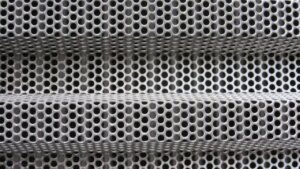Rotary Cutting Dies: The Processes Behind Them

What is rotary die cutting?
So—how do rotary cutting dies actually work, and why do we use them? Rotary die cutting separates itself from typical die cutting methods in a few different ways. Firstly, with this process we use a special cylindrical die, which cuts shapes out of our chosen materials. During rotary die cutting, the die moves in a circular motion, while blades move around the entirety of the cylinder. This executes the final shape—exactly how you want.
Rotary die manufacturers ensure that these machines work within their exact specifications by making small adjustments before processing. Although this can lead to a longer setup time, it ultimately results in more precise shapes. Whoever operates the die cutting machine must ensure that it remains restocked with flexible materials. During processing, they must in turn monitor the progression of the parts. This is why manufacturers must ensure they hire responsible, experienced operators—or invest in long-term training for new hires. This is one of many reasons why it’s common for business owners to work with third party manufacturers, rather than buying permanent equipment to keep in-house.
Typically, we choose rotary die cutting when working with materials like plastic, adhesive components, and metals. They’re relied upon in a variety of different engineering industries, which require components to be completely uniform in order for their systems to work effectively.
How do rotary cutting dies compare to flatbed die cutting?
Of all the potential rivals to rotary die cutting, flatbed die cutting may be the most prominent. These processes may seem similar on the surface, but they offer a number of key differences. Rather than utilizing rotary cutting dies, flatbed die cutting requires a hydraulic flatbed press to execute the required shapes and results.
Of course, we shouldn’t forget laser die cutting. This process distinguishes itself from rotary die cutting and flatbed die cutting by working with a laser rather than steel. The light from the laser executes the shapes, rather than the typical dies. By searing into the different materials, it creates the desired shapes. However, though this process can work under the right circumstances, it runs the risk of reacting poorly to light, resulting in its ultimate destruction.
What are the advantages of using rotary die cutting tools?
There isn’t a single die cutting process that reigns superior over the others. Rather, we select the die cutting process that works best for each specific order. While flatbed die cutting may suit low-volume projects, if you’d like to scale up, rotary die cutting is a far more effective solution. Rotary die cutting machines perform far more cuts in a shorter amount of time. Ultimately, rotary die cutting will almost always be the more efficient process, and we’re able to execute a superior edge with rotary die cutting.
What kinds of flexible materials can we process with rotary die cutting?
With rotary cutting dies, we can cut numerous different materials, forming the perfect, uniform shapes in large batches. Although we’ve already mentioned metals and plastics, let’s delve a little further into the adhesive component. Manufacturers process adhesive components perhaps more than any other types of materials—in part because of how broad the range of adhesives can be.
The typical converted flexible materials we process include industrial tape, medical adhesive, thermal interface, masking tape, cutting foam tape, surface protection, and more. Of course, certain materials tend to be more challenging than others. Consider elastic materials, as well as abrasive, thick, or unsupported materials. They aren’t impossible for us to process with rotary die cutting, but they do present unique issue that make the orders more difficult to fulfill (at times). Additionally, we often find these materials more expensive to process.
What types of projects require rotary die cutting?
Now that we’ve covered the materials we may processing with rotary cutting dies, let’s explore why we do it—what do these projects look like? Think of:
- Medical and wound care. We just mentioned how accessible we can make medical adhesives when using rotary die cutting. The medical industry relies on medical adhesive tape which means that medical and wound care companies require rotary die cutting orders on a regular basis. They require adhesives that are as breathable and flexible as possible.
- Surface protection. Here’s what surface protection actually pertains to: it covers tables in the medical and scientific fields. As with the adhesives above, these industries can’t function without surface protection. Enter the rotary die cutting machine!
- Thermal protection. Did you know that construction projects often require thermal masking tapes when cold weather is in play? It’s true—and we can trace that masking tape back to rotary cutting dies.
Ready to learn more about rotary dies and precision cutting tools in general? We’re ready to help at CTI. Give us a call at 419-924-5566 or contact us here. Let’s start!
- << < Previous Post
- 1
- 2
- ...
- 10
- ...
- 241
- 242 Next Post > >>

